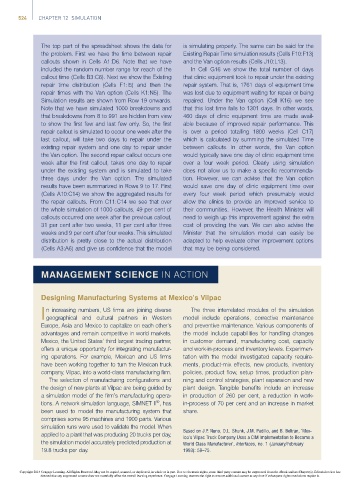Page 544 -
P. 544
524 CHAPTER 12 SIMULATION
The top part of the spreadsheet shows the data for is simulating properly. The same can be said for the
the problem. First we have the time between repair Existing Repair Time simulation results (Cells F10:F13)
callouts shown in Cells A1:D6. Note that we have and the Van option results (Cells J10:L13).
included the random number range for reach of the In Cell G16 we show the total number of days
callout time (Cells B3:C6). Next we show the Existing that clinic equipment took to repair under the existing
repair time distribution (Cells F1:I5) and then the repair system. That is, 1761 days of equipment time
repair times with the Van option (Cells K1:N5). The was lost due to equipment waiting for repair or being
Simulation results are shown from Row 19 onwards. repaired. Under the Van option (Cell K16) we see
Note that we have simulated 1000 breakdowns and that this lost time falls to 1301 days. In other words,
that breakdowns from 8 to 991 are hidden from view 460 days of clinic equipment time are made avail-
to show the first few and last few only. So, the first able because of improved repair performance. This
repair callout is simulated to occur one week after the is over a period totalling 1800 weeks (Cell C17)
last callout, will take two days to repair under the which is calculated by summing the simulated Time
existing repair system and one day to repair under between callouts. In other words, the Van option
the Van option. The second repair callout occurs one would typically save one day of clinic equipment time
week after the first callout, takes one day to repair over a four week period. Clearly using simulation
under the existing system and is simulated to take does not allow us to make a specific recommenda-
three days under the Van option. The simulated tion. However, we can advise that the Van option
results have been summarized in Rows 9 to 17. First would save one day of clinic equipment time over
(Cells A10:C14) we show the aggregated results for every four week period which presumably would
the repair callouts. From C11:C14 we see that over allow the clinics to provide an improved service to
the whole simulation of 1000 callouts, 49 per cent of their communities. However, the Health Minister will
callouts occurred one week after the previous callout, need to weigh up this improvement against the extra
31 per cent after two weeks, 11 per cent after three cost of providing the van. We can also advise the
weeks and 9 per cent after four weeks. This simulated Minister that the simulation model can easily be
distribution is pretty close to the actual distribution adapted to help evaluate other improvement options
(Cells A3:A6) and give us confidence that the model that may be being considered.
MANAGEMENT SCIENCE IN ACTION
Designing Manufacturing Systems at Mexico’s Vilpac
n increasing numbers, US firms are joining diverse The three interrelated modules of the simulation
I geographical and cultural partners in Western model include operations, corrective maintenance
Europe,Asiaand Mexico to capitalizeoneachother’s and preventive maintenance. Various components of
advantages and remain competitive in world markets. the model include capabilities for handling changes
Mexico, the United States’ third largest trading partner, in customer demand, manufacturing cost, capacity
offers a unique opportunity for integrating manufactur- and work-in-process and inventory levels. Experimen-
ing operations. For example, Mexican and US firms tation with the model investigated capacity require-
have been working together to turn the Mexican truck ments, product-mix effects, new products, inventory
company, Vilpac, into a world-class manufacturing firm. policies, product flow, setup times, production plan-
The selection of manufacturing configurations and ning and control strategies, plant expansion and new
the design of new plants at Vilpac are being guided by plant design. Tangible benefits include an increase
a simulation model of the firm’s manufacturing opera- in production of 260 per cent, a reduction in work-
Ò
tions. A network simulation language, SIMNET II , has in-process of 70 per cent and an increase in market
been used to model the manufacturing system that share.
comprises some 95 machines and 1900 parts. Various
simulation runs were used to validate the model. When
Based on J.P. Nuno, D.L. Shunk, J.M. Padillo, and B. Beltran, ‘Mex-
applied to a plant that was producing 20 trucks per day,
ico’s Vilpac Truck Company Uses a CIM Implementation to Become a
the simulation model accurately predicted production at World Class Manufacturer’, Interfaces, no. 1 (January/February
19.8 trucks per day. 1993): 59–75.
Copyright 2014 Cengage Learning. All Rights Reserved. May not be copied, scanned, or duplicated, in whole or in part. Due to electronic rights, some third party content may be suppressed from the eBook and/or eChapter(s). Editorial review has
deemed that any suppressed content does not materially affect the overall learning experience. Cengage Learning reserves the right to remove additional content at any time if subsequent rights restrictions require it.

